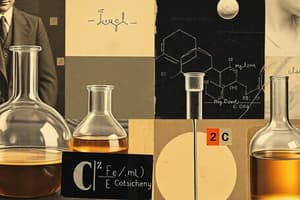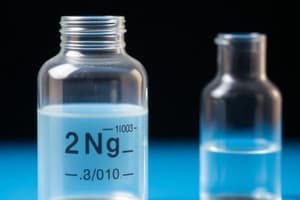Podcast
Questions and Answers
Which of the following is the best description of the 'mole'?
Which of the following is the best description of the 'mole'?
- The mass of a substance in grams.
- The amount of a substance containing 6.02 x 10^23 particles. (correct)
- The concentration of a solution in g/dm^3.
- The volume of a substance in liters.
Natural gas and crude oil are renewable sources of energy because they can be replaced quickly.
Natural gas and crude oil are renewable sources of energy because they can be replaced quickly.
False (B)
What process is used to separate crude oil into different fractions, and why is this process effective?
What process is used to separate crude oil into different fractions, and why is this process effective?
Fractional distillation; hydrocarbons have different boiling points.
The general formula for alkanes is CnH2n + ______.
The general formula for alkanes is CnH2n + ______.
Match the following terms with their descriptions:
Match the following terms with their descriptions:
What is the chemical formula for natural gas?
What is the chemical formula for natural gas?
Alkenes contain only single carbon-carbon bonds.
Alkenes contain only single carbon-carbon bonds.
State the conditions necessary for the hydrogenation of alkenes.
State the conditions necessary for the hydrogenation of alkenes.
Incomplete combustion of alkanes results in the formation of carbon monoxide, carbon dioxide, and ______.
Incomplete combustion of alkanes results in the formation of carbon monoxide, carbon dioxide, and ______.
Match the following prefixes with the number of carbon atoms they represent:
Match the following prefixes with the number of carbon atoms they represent:
What is the general formula for alkenes?
What is the general formula for alkenes?
Alkanes are generally more reactive than alkenes.
Alkanes are generally more reactive than alkenes.
Define the term 'homologous series' in organic chemistry.
Define the term 'homologous series' in organic chemistry.
The process of breaking down long-chain hydrocarbons into smaller hydrocarbons is called ______.
The process of breaking down long-chain hydrocarbons into smaller hydrocarbons is called ______.
Match the following terms with their corresponding definitions:
Match the following terms with their corresponding definitions:
Which of the following is an example of a biofuel?
Which of the following is an example of a biofuel?
During fractional distillation, heavier fractions with higher boiling points are collected at the top of the fractionating column.
During fractional distillation, heavier fractions with higher boiling points are collected at the top of the fractionating column.
Write the balanced chemical equation for the complete combustion of ethanol.
Write the balanced chemical equation for the complete combustion of ethanol.
Alkenes react with bromine, causing the reddish-brown color of bromine to ______.
Alkenes react with bromine, causing the reddish-brown color of bromine to ______.
Match the terms with their descriptions:
Match the terms with their descriptions:
Which of the following is a key difference between alkanes and alkenes?
Which of the following is a key difference between alkanes and alkenes?
The concentration of a solution in mol/dm^3 can be calculated by dividing the mass of solute in grams by the molar mass of solute in g/mol.
The concentration of a solution in mol/dm^3 can be calculated by dividing the mass of solute in grams by the molar mass of solute in g/mol.
Describe the process of liquefaction in the context of natural gas.
Describe the process of liquefaction in the context of natural gas.
The addition of hydrogen to alkenes is called ______.
The addition of hydrogen to alkenes is called ______.
Match the following properties to either alkanes or alkenes:
Match the following properties to either alkanes or alkenes:
Flashcards
Atomic Mass
Atomic Mass
The average mass of one atom of an element, relative to 1/12 the mass of a carbon-12 atom.
Molecular Mass
Molecular Mass
The average mass of one molecule of a substance, relative to 1/12 the mass of a carbon-12 atom.
Formula Mass
Formula Mass
The average mass of one unit of a compound, relative to 1/12 the mass of a carbon-12 atom.
Mole
Mole
Signup and view all the flashcards
Calculating Moles (from particles)
Calculating Moles (from particles)
Signup and view all the flashcards
Calculating Moles (from mass)
Calculating Moles (from mass)
Signup and view all the flashcards
Concentration of a Solution
Concentration of a Solution
Signup and view all the flashcards
Concentration (g/dm^3)
Concentration (g/dm^3)
Signup and view all the flashcards
Concentration (mol/dm^3)
Concentration (mol/dm^3)
Signup and view all the flashcards
Hydrocarbons
Hydrocarbons
Signup and view all the flashcards
Natural Gas
Natural Gas
Signup and view all the flashcards
Crude Oil
Crude Oil
Signup and view all the flashcards
Liquefaction
Liquefaction
Signup and view all the flashcards
Fractional Distillation
Fractional Distillation
Signup and view all the flashcards
Biofuels
Biofuels
Signup and view all the flashcards
Organic Compounds
Organic Compounds
Signup and view all the flashcards
Homologous Series
Homologous Series
Signup and view all the flashcards
Alkanes
Alkanes
Signup and view all the flashcards
Combustion (of Alkanes)
Combustion (of Alkanes)
Signup and view all the flashcards
Substitution (of Alkanes)
Substitution (of Alkanes)
Signup and view all the flashcards
Alkenes
Alkenes
Signup and view all the flashcards
Hydrogenation
Hydrogenation
Signup and view all the flashcards
Bromination
Bromination
Signup and view all the flashcards
Polymerization
Polymerization
Signup and view all the flashcards
Cracking
Cracking
Signup and view all the flashcards
Study Notes
Atomic, Molecular, and Formula Mass
- Atomic mass is the average mass of one atom of an element, relative to 1/12 the mass of a carbon-12 atom.
- Molecular mass is the average mass of one molecule of a substance, relative to 1/12 the mass of a carbon-12 atom.
- Formula mass is the average mass of one unit of a compound, relative to 1/12 the mass of a carbon-12 atom.
Moles and Molar Mass
- A mole contains 6.02 x 10^23 particles of a substance; these particles can be atoms, molecules, ions, or electrons.
- To calculate the number of moles: divide the number of particles by 6.02 x 10^23.
- Moles can be calculated by dividing the mass of a substance (in grams) by its molar mass (in g/mol).
- The concentration of a solution refers to the amount of solute dissolved in a unit volume of solvent.
- Concentration in g/dm^3 is calculated by dividing the mass of solute (in grams) by the volume of solvent (in dm^3).
- Concentration in mol/dm^3 is calculated by dividing the number of moles of solute by the volume of solvent (in dm^3) or by dividing the concentration in g/dm^3 by the molar mass of solute (in g/mol).
Stoichiometry
- Step 1: Calculate the number of moles of the reactant or product using the given information.
- Step 2: Determine the number of moles of the desired substance using the mole ratio from Step 1.
- Step 3: Calculate the answer using the number of moles obtained in Step 2.
Natural Gas and Crude Oil
- Fossil fuels, known as hydrocarbons, consist of carbon and hydrogen only and are formed by the decomposition of plants and animals.
- Natural gas is a gaseous fossil fuel with the chemical formula CH4.
- Crude oil, also known as petroleum, is used to make other chemicals (e.g., plastic) or burnt for energy and is made up of hydrocarbons with different properties.
- Natural gas undergoes liquefaction to become liquefied natural gas (LNG) for easier transport due to its smaller volume.
- Crude oil requires separation into different groups before usage.
- Natural gas and crude oil are non-renewable energy sources with limited supplies that cannot be replaced quickly enough.
Separation of Crude Oil
- Fractional distillation separates crude oil into useful fractions because the hydrocarbons in crude oil are miscible and have different boiling points.
- In fractional distillation: 1) Petroleum is heated into a vapor in a furnace. 2) The vapor is passed into a fractionating column. 3) The vapor cools and condenses as it rises. 4) Lighter fractions with lower boiling points are collected at the top as gases. 5) Heavier fractions with higher boiling points are collected at the bottom as residue.
Biofuels
- Biofuels are renewable alternative energy sources, unlike crude oil and natural gas.
- Ethanol (bioethanol) can be produced from the sugar in plants like sugarcane.
- Sugarcane can be regrown quickly, making the ethanol produced a renewable resource.
- Sugarcane absorbs carbon dioxide during photosynthesis, which helps offset the carbon dioxide produced during fermentation, making burning ethanol environmentally friendly.
- The chemical equation for the combustion of ethanol: C2H5OH + 3O2 → 2CO2 + 3H2O.
Homologous Series
- Organic compounds contain carbon atoms covalently bonded to other elements like hydrogen, oxygen, and nitrogen.
- A homologous series features compounds with: the same general formula, similar chemical properties, the same functional group, each member differing by a CH2 unit, and gradual changes in physical properties (e.g., increased melting and boiling points, density, and viscosity).
Properties of Alkanes
- Alkanes are hydrocarbons containing only carbon-carbon and single bonds.
- The general formula for alkanes is CnH2n+2, and their names end with "-ane."
- Alkanes have weak intermolecular forces of attraction, resulting in low melting and boiling points.
- Viscosity increases with molecular size due to stronger intermolecular forces.
- Alkanes are insoluble in water but soluble in most organic solvents, making them useful as solvents for other organic compounds.
- Alkanes burn in excess air (oxygen) to produce carbon dioxide and water vapor.
- Flammability decreases as molecular size increases.
- Alkanes react with halogens (e.g., Cl2, Br2) in the presence of UV light via substitution.
- Incomplete combustion occurs with insufficient oxygen, forming carbon monoxide, carbon dioxide, and soot.
Properties of Alkenes
- Alkenes are hydrocarbons containing carbon-carbon double bonds.
- The general formula is CnH2n, and their names end with "-ene."
- Alkenes are unsaturated hydrocarbons.
- Physical properties are similar to alkanes.
- Alkenes burn in excess oxygen to produce carbon dioxide and water vapor but with sootier flames.
- Alkenes are more likely to undergo incomplete combustion due to a higher percentage of carbon by mass.
- Alkenes undergo addition reactions where the double bonds break to form new single bonds.
Hydrogenation
- Hydrogenation involves adding hydrogen to alkenes to form alkanes, requiring conditions of at least 150 degrees Celsius and a nickel catalyst.
- Margarine production is an example of hydrogenation of vegetable oil.
Bromination
- Alkenes react readily with bromine, decoloring the reddish-brown color of bromine (turns colorless).
- This reaction distinguishes alkenes from alkanes and saturated from unsaturated compounds.
- Alkanes do not change the color of bromine.
Polymerization
- Polymerization involves monomers (alkene molecules) reacting with each other to form a long polymer molecule under high temperature and pressure with a catalyst.
Methods for Producing Alkenes
- Cracking breaks down long-chain hydrocarbons into smaller hydrocarbons and hydrogen.
- It occurs at high temperatures (500-700 degrees Celsius) with a catalyst like silicon dioxide.
- Alkenes are obtained by cracking petroleum or crude oil.
Similarities and Differences Between Alkanes & Alkenes
- Both are hydrocarbons and flammable.
- Both burn completely in excess air to form carbon dioxide and water vapor.
- Alkanes are saturated, containing only single carbon-carbon bonds, while alkenes are unsaturated, containing double carbon-carbon bonds.
- Alkanes don't react with aqueous bromine, while alkenes decolorize bromine's reddish-brown color.
- Alkanes are generally unreactive and undergo substitution reactions, while alkenes are very reactive and undergo addition reactions.
- Alkanes do not undergo polymerization, but alkenes do.
- Alkanes produce a less smoky flame, while alkenes produce a more smoky flame.
Studying That Suits You
Use AI to generate personalized quizzes and flashcards to suit your learning preferences.





